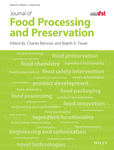Key hurdles in the Mediterranean-style dry fermented sausage “Salsiccia Sarda” as influenced by different ingredients related to product safety
Abstract
According to EC Reg. 2073/2005, Food Business Operators must demonstrate the safety of fermented sausages by using different approaches based on physico-chemical analyses, predictive microbiology and Microbial Challenge Test. The aim of the present study was to investigate the application of different ingredients related to product safety on the development of key hurdles in Mediterranean-style dry fermented sausages as “Salsiccia Sarda”. Weight loss, pH and aw were evaluated as ripening monitoring tool. Predictive mathematical models to evaluate the survival of Listeria monocytogenes complemented the present study. The evolution of aw and weight loss to values capable to support product's safety was shown to be closely related and was validated as a simple and effective monitoring tool of the Critical Control Point ripening. Based on the fermented sausage characteristics, “Salsiccia Sarda” at the end of ripening is unable to support the growth of the pathogen.
Practical applications
The correlation between weight loss and aw was validated as a simple and effective monitoring tool of the CCP ripening. The inclusion of a flavour stabilizer based on hydrolyzed pork proteins showed some effects on the aw evolution: the use of this additive can bring benefits in terms of assuring a constant safety of the final products and addressing the needs of reducing the cost of production. The empirical application of the hurdle technology in the production of “Salsiccia Sarda” highlights the need for Food Business Operators (FBOs) to carefully evaluate the physico-chemical properties of the products and to control the ripening stage more effectively ensuring the production of fermented sausages with aw and pH values than can support product's safety.




